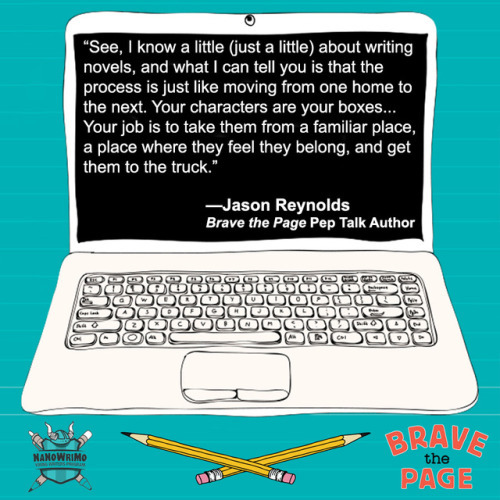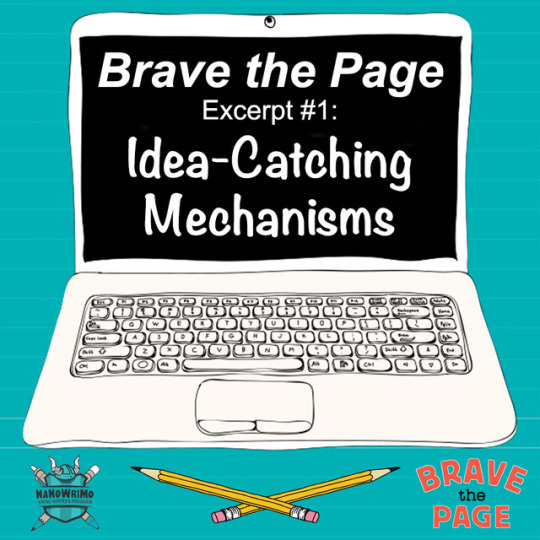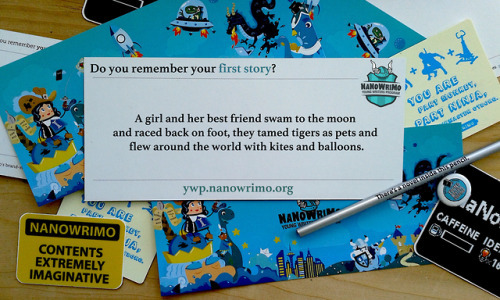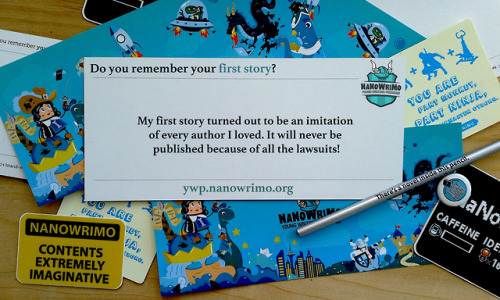Chris Baty's Blog, page 75
August 19, 2019
Just one week until our new book, Brave the Page, comes out!...

Just one week until our new book, Brave the Page, comes out! Here’s a snippet from author Jason Reynolds’ introduction.
“See, I know a little (just a little) about writing novels, and what I can tell you is that the process is just like moving from one home to the next. Your character are your boxes… Your job is to take them from a familiar place, a place where they feel they belong, and get them to the truck.”
—Jason Reynolds,
Brave the Page Pep Talk author
August 16, 2019
5 Writing Dares (featuring the Traveling Shovel of Death)Start...
5 Writing Dares (featuring the Traveling Shovel of Death)
Start writing NOW with these five dares, whether you’re in the middle of your project or looking for a way to begin. All dares provided by the Dare Machine on NaNoWriMo’s Young Writers Program website.
1. Your character discovers an inanimate object that laughs.
2. Create a human character based on your pet.
3. Make a character climb a tree.
4. Give one of your characters amnesia.
5. Have a character find an unlucky penny.
Plus one extra non-writing dare for us to watch out for!
Darer: Communications Manager Katharine Gripp
Balancer: YWP Director Marya Brennan
August 14, 2019
BRAVE THE PAGE Excerpt: Idea-Catching Mechanisms

Brave the Page, our brand new NaNoWriMo handbook for young writers, is available for pre-order! Partly a how-to guide on the nitty-gritty of writing, partly a collection of inspiration to set (and meet) ambitious goals, this is our go-to resource for middle-grade writers. Check out this Brave the Page excerpt on generating novel ideas:
Idea-Catching Mechanism #1: Mine Your Life“You get ideas from daydreaming. You get ideas from being bored,” author Neil Gaiman wrote. “The only difference between writers and other people is we notice when we’re doing it.”
When you mine your life, you look back through your past to extract sparkling sapphires as well as pieces of combustible coal. You dig deep to uncover experiences and emotions and memories and dreams, and then you gather them in a pile and watch as they ignite and spark story ideas.
The nuggets you mine from your past don’t need to be epic or amazing or tragic (though they can be). They can be simple moments or heated conversations or the smell of your favorite holiday. It can be that time when you were three years old and used your mom’s lipstick as a crayon on the freshly painted wall. Or that feeling you got when you aced (or failed) your math test. Or the color of the sky after you saw your grandfather for the last time.
Your memories might lead to wild new ideas. Or they might serve as a foundation upon which you build your story, as with author Joyce Hansen’s book The Gift-Giver, which came out of her past experiences. “I recalled my own childhood as I created the story, so that underneath what seems to be a contemporary middle-grade novel is actually a nostalgic memory of my years growing up in a Bronx neighborhood in the late 1940s and early fifties.”
To get started on mining your life, take 10 minutes to write down (or draw) as many memories, experiences, and dreams as you can. Include a lot of details or a single word-whatever works for you. Do this every day for a week.
Here are a few prompts to guide you if mining memories from your whole life feels too big:
Holidays or special gatheringsA time you tried something newSchool events or field tripsA time that was particularly funny, happy, or sadFamily members or petsA time you were scared or embarrassedYour earliest memoriesAugust 12, 2019
5 Tips to Smooth the Edges of Your Rough Draft

Sometimes, it’s easy to get caught up in the pure rush of creating something new. Later on, when you come back for a second glance, the writing doesn’t have that same sparkle. You may not want to hear this, but editing is your friend—and it doesn’t have to be a painful process. Today, NaNoWriMo participant Rebekah reminds us that editing is writing:
Editing the rough draft of a story is a dreaded part of writing.
It takes just as much, if not more time, than actually writing a draft. But never fear! I’ve created my own method of tackling the first draft that I’d like to share with all of you as you work on your stories.
I find tips easier to follow if I’m given steps, so here is a step-by-step of the process I have been following with the rough draft of my very first book.
1. Let the draft sit for at least a month.This means don’t touch it at all. Don’t read it, don’t do tiny edits. If it helps, pretend it doesn’t exist. Taking a break from the draft helps me distance myself from what I wrote. It makes the text almost seem like it was written by someone else, which can make it easier to critique and fix.
2. Read the draft after the break period and don’t edit it at all.Read it like you would a new book and document all issues you find. This will make it easier to write the next draft.
3. Find a format for your story that will be the easiest for you to edit.For me, it meant printing out the whole story, which then led me to realize something to work on in draft two (more on that in step 4). Writing in red ink all over a hard copy of my first draft has helped me, and more importantly, I’m comfortable with it. If you aren’t comfortable with editing in your story’s current format, then find another format that works.
4. Find at least one thing to look at throughout your editing process.This is by far a harder step, but once you do it, the editing process becomes a whole lot easier. I realized my chapters were too short, so I decided to find ways I could build more plot into my chapters. Other common fixes could involve decreasing adverbs and using more emotions. This gives you a goal while editing, which can be helpful to writers like me who are very goal-oriented.
5. Make a “chapter wrap-up”.This is a completely optional step, and may only work for some writers, but it has helped me immensely. I call it a chapter wrap-up, and write it out after I finish editing a chapter. It includes four sections: Characters, Plot Points, Items to Adjust, and Connections/Extra Analysis.
Under Characters, I list the characters present in the chapter and the new ways they’ve developed. Under the Plot Point section, I mention all major plot points for reference in future drafts. My Items to Adjust section includes my major flaws in the chapter as wells as smaller issues to adjust. The Connections/Extra Analysis section includes any other information I find important to include after editing a chapter.
This list has worked the best for me, but every writer is different. Improvise on this list, or find your own way! Tackle that first draft and start editing!
Rebekah lives in the United States. When she isn’t writing, you will likely find her reading comics or books, playing on her tenor or alto saxophone, listening to soundtracks, knitting, or taking nature walks. She hopes to publish her current book by the end of high school. You can find her on Instagram.
Top photo by Sharon McCutcheon on Unsplash.
August 9, 2019
Happy National Book Lovers Day, Wrimos!Take some time today to...





Happy National Book Lovers Day, Wrimos!
Take some time today to read or share one of your favorite books. (Maybe it’s your own!) To celebrate, we’d like to share the very first stories written by a few NaNoWriMo participants. Do you remember yours?
Question: Do you remember your first story?
IMG 1: A science fiction epic about myself, in which I stumbled on a mad scientist’s serum that made your thumbs grow to gigantic proportions.
IMG 2: A girl and her best friend swam to the moon and raced back on foot, they tamed tigers as pets and flew around the world with kites and balloons.
IMG 3: My first story was about four kids left behind after a camping trip on an island in Florida.
IMG 4: My first story followed four girls that lived at a boarding school. Strange things began to happen and they set out to find the cause.
IMG 5: My first story turned out to be an imitation of every author I loved. It will never be published because of all the lawsuits!
August 7, 2019
4 Ways to Turn Your Writing Struggles Into Stories

Sometimes, it’s easy to identify what your character’s struggle with. Other times, it’s something shadowy lurking under the surface. Today, Young Writers Program Participant Amanda Harrison offers some tips on turning that struggle into a narrative arc:
1. When you’re about to begin writing, make sure you have a plan.You don’t necessarily have to go into it with a strict day-to-day agenda, because that can take away from the fun of writing, but it is important to have a general idea of the characters in your story and what direction the conflict is going in.
A good way to start organizing your ideas and elements of your story is to have some sort of notebook devoted to it. Having a specific place to keep everything about your book can help you straighten out any information that doesn’t exactly match up, fill plot holes, and keep track of all the important aspects of your story (characters, government and/or magic systems, places, etc.). After having everything in your story written down is when your writing becomes easier.
2. Don’t make a story without a conflict or a goal your protagonists are working for or against.If you’re having trouble coming up with your main character’s struggle in the story, take a look at their insecurities and faults, and you will most likely be able to come up with your story’s problem easily.
In my current story I’m working on, I’ve had trouble thinking of my conflict, but after taking a break from writing and going back to my story’s outline and my character lists, it’s become easier to think of a conflict and execute it in my story. I took a look at my protagonist, Jacob, and tried thinking about his personality. Jacob’s main fear is having the people he cares about taken away from him. Two parts of the conflict I have are him having to leave his family for good, and having an outside force take away his new family/friends.
3. Shake it up! If your story is boring to you, it’s not going to be exciting for your readers.It’s not that the story itself is bad, but without your conflict, your story won’t develop well. If you do have a conflict in mind, but are still in the exposition or rising action, try adding in backstories for less important characters who might play a crucial role in the story later, or write a bit about the villain in your story.
Another thing you can try is creating a side story for your main characters; showing how they got where they are today. And don’t let us forget about everyone’s favorite thing to write: plot twists. If you’re having trouble writing, try putting yourself in your readers’ shoes. Think of something your characters wouldn’t do; a sort of rebellion, an action that would throw everyone in your book off guard.
When you’re writing, lead your audience away from the plot, make them think they know what is going on or give them a sense of closure on the subject, drop a few subtle hints the readers will notice after reading the twist, then drop that reading bomb on your readers!
4. And lastly: don’t stress!Remember, you should be writing because you enjoy it! Don’t make a goal too monumental for yourself, in terms of your schedule, and how much you as a writer are able to write.
Amanda Harrison is a 13 year old writer, and is about half way through her first rough draft of her novel she’s writing, using camp Nanowrimo (although it’s mostly her procrastinating and talking to her cabin-mates from Cricket) Amanda also writes on Cricket Magazine’s ‘Chirp at Cricket’ website. On her free time, you can find Amanda playing piano or ukulele, playing basketball, or singing whatever Broadway song is stuck in her head at the top of her lungs.
Top photo by Anna Samoylova on Unsplash.
August 5, 2019
4 Tips to Stay Zen While Editing

So, you’ve said a tearful so long to your cabin mates. It’s time to go “home” now. Camp NaNoWriMo has been an amazing experience. All your hard work has paid off. But, it isn’t over, yet. Now, comes the truly fun part—Revision and Editing! Today, YWP Participant Joy Wambeke offers some helpful hints on making the revision process less painful and more fruitful:
I know how tough it is to write your entire first draft.
You go over it, fix grammar mistakes, go over it again, fix more mistakes, go over it again, replace, delete, add fresh sentences, paragraphs, then fix more mistakes, and still go over it again. Then, when you think it’s in good shape, you have someone else read it only to find there are more mistakes, and some things don’t make sense. Then you have to repeat all of the above, until you finally end up with a polished draft.
That’s what I did for my book, and I still have lots of grammar mistakes and some things still don’t make much sense. But the point I’m trying to make is that I DID IT! Even though you have to go through a whole lot of trouble to make your book what it is, it’s worth it! Winner or not (this time), when all is said and done, YOU DID IT!
So, here is some advice for getting through all the messy revision process:
1. RestYou can have a break. You don’t need to be on it all the time (although if you take too long, you’ll never finish it).
2. ThinkThink about how well you want your book fixed up.
3. Meditate and/or SleepThis is pretty close to number one, but targeted on two different kinds of rest. You will need your sleep as much as possible. Go to bed on time and if you can, sleep in or take an afternoon nap. Meditating helped me a lot when I got frustrated with my work. I would search for a video, some poses of yoga or I would just stretch and listen to calming music.
4. MotivationI found that if you tape up posters of inspirational quote on how to keep going or how good it feels at the end around where your working so then when you look around, you’ll get motivated to keep going and not give up.
I hope you come out with a great book!
Joy is 12 years old and started writing at 5. Joy has written one book so far (other than little short stories) called “Living in Boredom”.
Top photo by dorota dylka on Unsplash.
July 31, 2019
Don’t Get Stuck, Get Going!

We’ve all been there, chasing down some magical plot bunny, that seems to be leading us to our narrative destiny. Then, somewhere along the way, that plot bunny seems to disappear into thin air and leave us stranded on the trail to who knows where. Today, NaNoWriMo Participant K.S. Trenten reminds us that when the going gets tough, the tough… start talking to themselves :
Uh oh. You started out with a good story, it was moving forward, only now you’re not sure what to write. You’re stuck.
How do you get moving again?
Sometimes a simple solution is to move around. Get up. Cross the room and pour yourself a cup of coffee. Go for a walk. See if stirring from the spot you’re sitting in doesn’t shake up your imagination a bit, jarring something loose you hadn’t thought of. An idea may tumble free in the process, giving you the impetus to get your story going again. Perhaps you should pick up your writing tools and relocate somewhere else. Physical movement often gets my mind moving as well.
Nor is that the only way to get going.
Take up your writing implements. Start venting. Not just writing, venting. Let all of your frustration about being stuck on the page out in your words. Confide all your hopes and dreams you had for this particular story to the page. Let the character know they’re not satisfying you, exactly how and why they’re being difficult. If some other story has distracted you, taunt them about all the reasons why you’re enjoying the other story more than them. Allow the characters to talk back. Let them get as uppity as they want, letting you know exactly why they’re not behaving the way you wish them to.
Seriously, I write weekly blogs which are my characters just mouthing off. A writer can learn some surprising things if you let them talk back.
Something else which may have gotten you stuck is that all your insecurities about your writing are coming back to haunt you. You cannot shut them up. Getting stuck has only made them louder.
Fine. Dedicate a page to a major snark-off with your insecurities. Write down every nasty thing you fear. Talk back to them. Come up with a retort for everything they say. Is there any truth in these insults, really? What can you do to change your writing if something about it really is bothering you?
Don’t get upset if you’re truly afraid, deep down, that you are stuck. Writing is no different than most anything else. With time and practice, you can become quite skilled. Do it often enough and you will improve. Look your fear right in the eye and ask why? What would you like to change to get better? How can you go about it? Are you shaky at descriptions? Use too many telling words or too much passive description? (I was guilty of both and still am.)
Don’t shrink from your faults. Face them. Contemplate ways to fix them.Look at others writers you admire. What would you like to do, that they do? Anne Rice wrote exquisite descriptions I’d drool over in envy. I made the mistake, at first, of trying to write like her, to imitate her. I studied her work closely, tried to detect exactly why I found her descriptions exquisite. She used very simple words to create complex, compelling settings and characters. I started pruning some of the big, fancy words from my prose and tried to express things in more common words. Certain descriptive passages in my own stories improved. I even started getting compliments on them!
Life isn’t always smooth. Neither is writing. In both, you’ll hit rough patches. You can’t always avoid these patches, even though you may get better at dodging them with practice. The trick is to pick yourself up out of the patch. Keep going, even if you’re sore, shaky, and your pride feels a little banged up.
You’re not alone. We’ve all fallen into potholes, been hit over the head with obstacles, or smashed our stories against a block.
Get up. Give yourself a hug. Find a way to keep going, to find your way back to your plot or for your plot to find its way back to you. Abandon it entirely if you need to go in a different direction, but don’t give up.
You’re not over yet. Not if you decide you’re not.

K.S. Trenten lives in the South Bay Area of California in the United States with her husband, two cats, and a host of characters in her imagination, all shouting out for attention. Her published works include Seven Tricks; A Symposium in Space; Fairest (part of the Once Upon a Rainbow LGBTQIA+ fairytale anthology) and At Her Service (part of the Once Upon a Rainbow 2 anthology); and The Closet (part of Queer Sci Fi’s Impact, a collection of flash fictions). She also offers weekly samples of her work on Mondays and Saturdays at the Cauldron of Eternal Inspiration, Wednesdays at the Formerly Forbidden Cauldron, monthly blogs at cauldronkeeper.livejournal.com, rhodrymavelyne.dreamwidth.org, and is the author of Queer Sci Fi’s Sources of Inspiration column. She can be found on Twitter, tumblr, LinkedIn, and has a Facebook Author Page, which reflects the contents of both Cauldrons.
July 29, 2019
10 Tips to Keep You Writing

What do you do after that first spark of inspiration fades away? Today, Camp NaNoWriMo Participant Shalom Goodrich offers some helpful hints on how to keep writing when you feel stuck:
Are you positively out of creative popsicles? No more new goggles to try? Well, here are ten tips on how to snap out of that catnap and start fighting for writing!
1. Take a walk. No matter how boring it may sound, it really will help. Just breathe deeply and take in the nature (or city sights) around you.
2. Read a chapter of a book. Some good ones to inspire creativity are The Hunger Games, Under the Lilacs, Insignificant Events In the Life of a Cactus (one of my personal favorites), or Bruchco.
3. Write about your day, good or bad, for at least ten minutes. Or, you can make up a word, then write a story that includes the word. Then go back to working on your project.
4. Play a board game with a friend. Boggle, Stratego, and any memory game are all good brain teasers.
5. Watch a video on how to make an origami bookmark. Then do it three times. Set yourself a creative task with clear instructions where you can let your mind wander a little.
6. Paint a picture of a scene in your book. If you find that this is feeling good and inspiring, choose another scene!
7. Do something else and let your brain rest. Pick an activity as different from writing as you can possibly get.
8. Take a nap. If you are tired, that can really affect your writing (sometimes it can be good; more often than not it’s bad).
9. Listen to the Pirates of Penzance soundtrack on either spotify or youtube. It’s really funny and interesting, something to take your mind off writing and leave it refreshed. If you can, watch the movie.
10. Take a bike ride, go swimming, or run around the neighborhood. Similar to taking a walk, use up some energy and refresh your brain.
I often encounter writer’s block after finishing a large event in my writing, when I try to start a different novel or a new chapter. For me, it’s so hard to start, but the best way to cope with this is to start writing and don’t stop. You can always go back and edit it again.
Shalom Goodrich lives in Salt Lake City, Utah. She is the oldest child out of six and currently enjoys writing, baking all kinds of stuff, and going on pointe at ballet well as biking two and a half miles there and back. She self-published one novel, Jewelvaria, which is available at lulu.com
Top photo by photo-nic.co.uk nic on Unsplash.
July 26, 2019
Camp Pep: The Heart of Your Story is You

We’re in the last week of Camp NaNoWriMo! The clock is ticking. How will you make the most of the final countdown? Today, NaNoWriMo Participant Rosario Martinez reminds us to leave our excuses at the door and put that pen to paper/fingers on the keyboard:
Many will say there is no trick to writing other than to sit and write.
It’s hard to do that sometimes. Life will happen. We all have valid reasons not to write. It’s true. There are things, people, and situations that will make us think twice about writing. They deserve our attention because they are too important to us. But you know what? The real trick to writing is this. If you didn’t already know, let me be the one to tell you. Your story is important. Your story is important because only you can tell it.
No one can tell your story the way you know it — no one but you.The heart of your story is you.
At this moment in time, only you know your story, and it is important for that very reason. The way you see it when you close your eyes, feel it as your fingertips press the keyboard, or the tip of your pen glides across the paper, your story exists only because you made it so.
That excitement that made you want to write in the first place, that spark? It’s still there hiding—waiting for you.The words you write matter because only you can write them. The act of writing can sound daunting sometimes, even more so when there’s a word count involved. Sometimes those are the things that keep us away from writing rather than inviting us in. But your commitment isn’t to a word count. It’s to the story you want to tell. The words that are tugging inside your head, begging you to write them.
Be flexible, write when you can, write what you can, but keep writing.Even when you don’t know what comes next: write. Even when it doesn’t make sense: write. It can be anything. You never know where creating a character’s backstory might lead you to their inner conflict in your story. One thing can lead to another. It takes one word to set everything in motion. Setting time aside, it can be just minutes at a time. Bite-size. You’ll surprise yourself. You can make your word count because you can always change it. Don’t think about what hasn’t been done or how much time you have left. When you remove those restrictions from your writing time, you’ll think clearer, and the story will pop up again. What matters is that you tell this story.
Think of the way your story comes alive when you think about it. Think of the words and watch them jump off the page as you’re writing them. Think of how much you want to know your characters. Who are they? What are they hiding? And why do they want you to write them? Your story is important to you, and someday it will be important to someone else, too. What is this story, your story? Remember that you are the only one that can write it. Only you.
Let your words lead you down the unexpected, the bright and dark corners that you wish to explore.This story, your story, can only be told by you.

Rosario
Martinez is a science fiction and fantasy writer. She lives in Dallas,
Texas with her husband and their four sweet but demanding cats. She’s
currently working on her debut YA fantasy novel. She has too many
flannel things and believes a good bowl of nachos is life. To follow her
journey to publication, visit her literary lifestyle blog (https://lemmonavenue.net) or find her on Twitter @rosariomwrites and Instagram @rosariomwrites
Top photo by Steve Halama on Unsplash.
Chris Baty's Blog
- Chris Baty's profile
- 63 followers



